Gentiana lutea L. - Gentianaceae - yellow gentian, great yellow gentian, Gelber Enzian
Perennial herb, up to 150cm tall, native to the mountains of Central and South Europe, endangered; rootstock thick like an arm (up to 1m long, 3-5cm diam., up to 7kg fresh weight); leaves broad elliptic, parallel veined, blueish green; flowers yellow.
„Gentian root is a traditional bitter tonic that stimulates appetite. It is a roborant and cholagogue, and is used in case of poor appetite, flatulence and bloating, as well as for dyspepsia with anorexia… The bitter substances stimulate the taste buds and promote (as reflex via the nervus vagus) the flow of saliva, gastric juices and bile.“
[Medicinal Plants of the World. Ben-Erik Van Wyk and Michael Wink, Pretoria 2004, 155]
An „… HPLC-method enables the determination of all major, currently known bioactive compounds in gentian roots. A separation of iridoids (loganic acid), secoiridoids (swertiamarin, gentiopicroside, amarogentin, sweroside), xanthones (gentisin, isogentisin) and two xanthone glycosides (gentiosides) was possible on RP-18 column…
Analysis of several commercially available G. lutea samples showed that gentiopicroside is the most dominant compound in the specimens (4.46–9.53%), followed by loganic acid (0.10–0.76%), swertiamarin (0.21–0.45%) and the xanthone glycosides. Gentisin and isogentisin were found in much lower concentrations between 0.02 and 0.11%, respectively.“
[Quantitative analysis of iridoids, secoiridoids, xanthones and xanthone glycosides in Gentiana lutea L. roots by RP-HPLC and LC-MS., Aberham, A., Schwaiger, S., Stuppner, H., Ganzera, M., Journal of Pharmaceutical and Biomedical Analysis, Vol.45(3), 2007, 437-442]
The bitterness of the dried roots (Radix gentianae, Gentianae radix, Bitterwurzel) is determined by amarogentin (bitterness value 58 000 000) and not by the main component gentiopicrosid (bitterness value 12000). Amarogentin is located mainly in the root bark; traded material contain usually 0.1-0.5mg/g (dry mass) and may reach 2mg/g.
[Hagers Handbuch der Pharmazeutischen Praxis, Springer 2010]
Bitterness values of roots seem to correlate with the altitude of cultivation.
[Untersuchungen über den Einfluss des Gebirgsklimas auf den Wirkstoffgehalt einiger Arzneipflanzen (Doctoral dissertation, Diss. Naturwiss. ETH Zürich, Nr. 1028, Bänninger, A. (1939)]
http://e-collection.library.ethz.ch/eserv/eth:21789/eth-21789-02.pdf?pid=eth:21789&dsID=eth-21789-02.pdf

Köhler, F.E., Medizinal Pflanzen, vol.2, t.134 (1890)
http://plantgenera.org/species.php?id_species=459153


